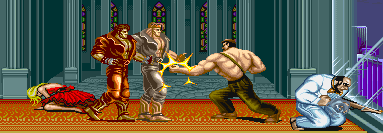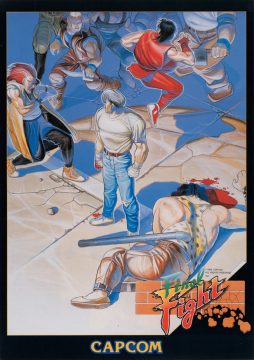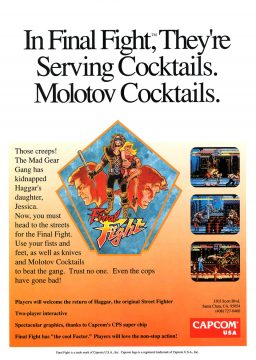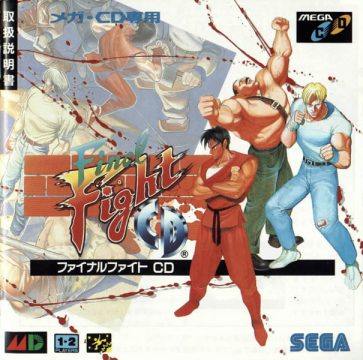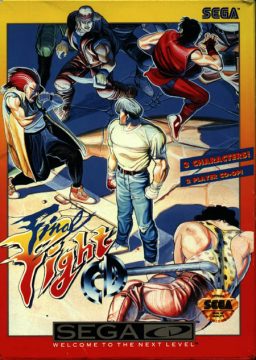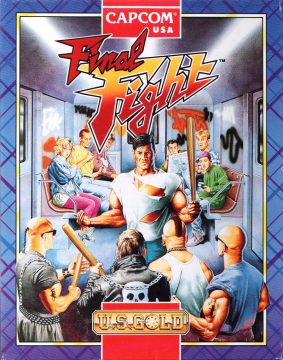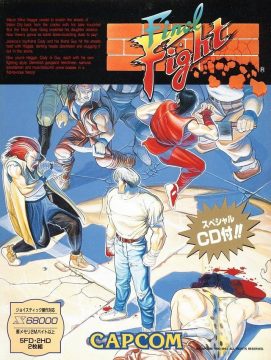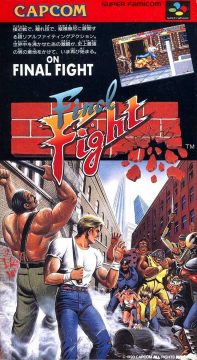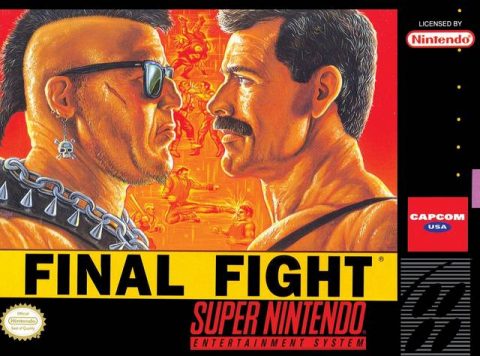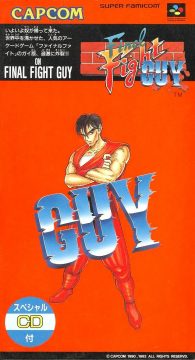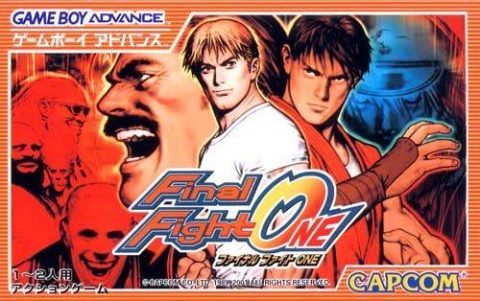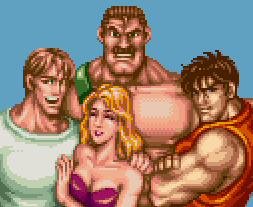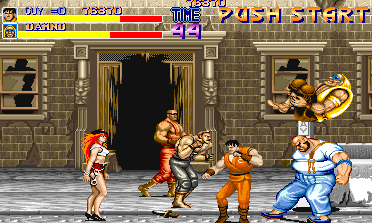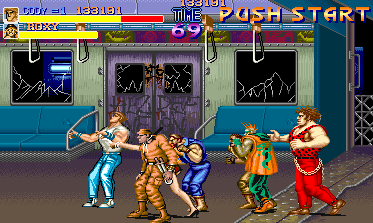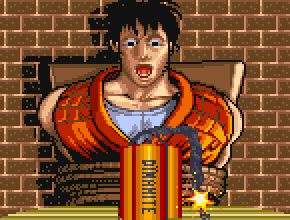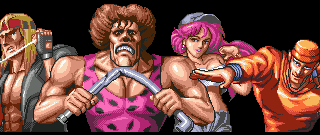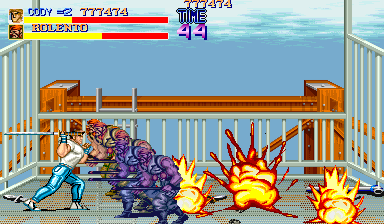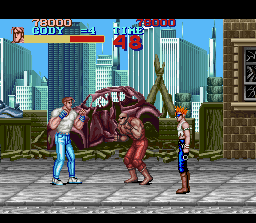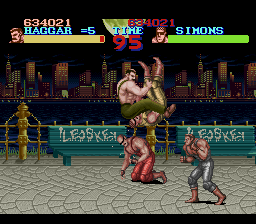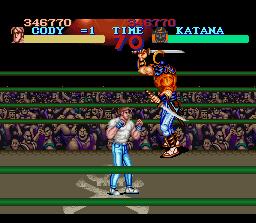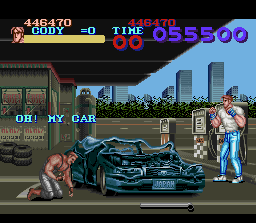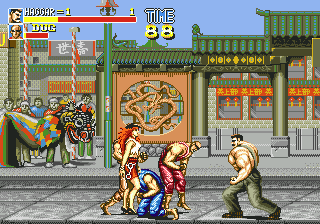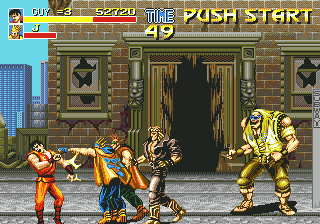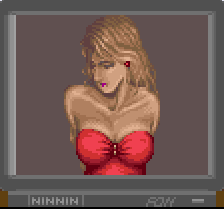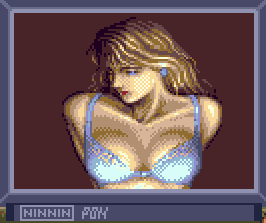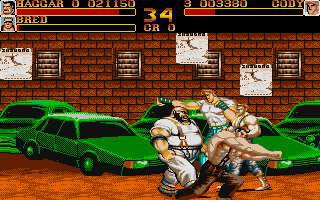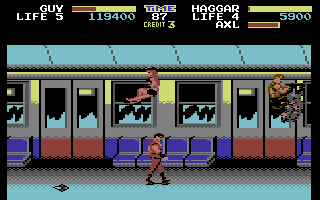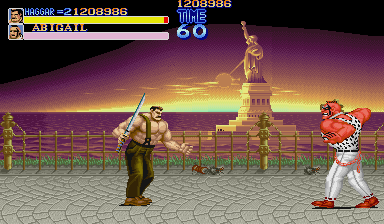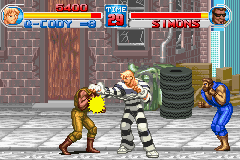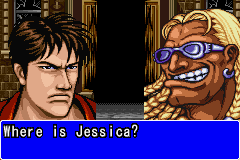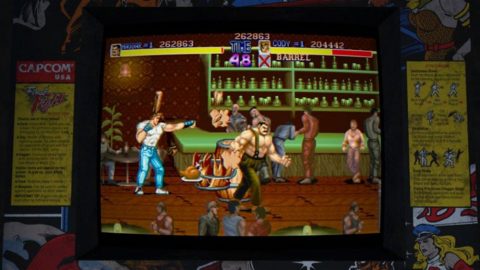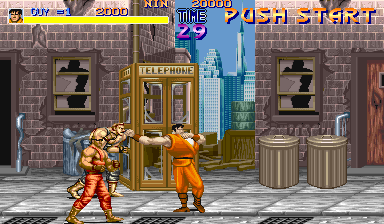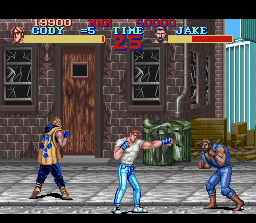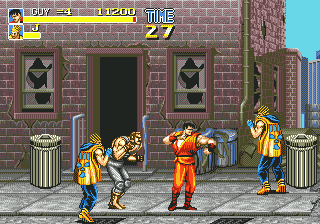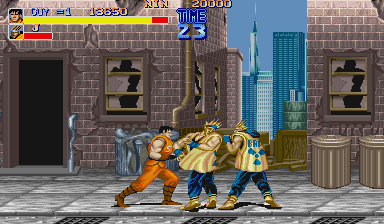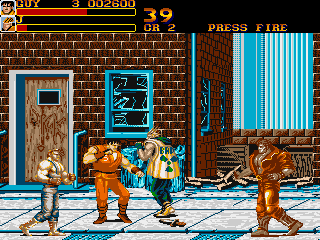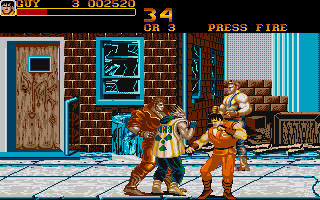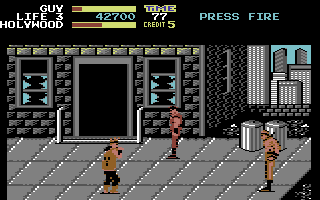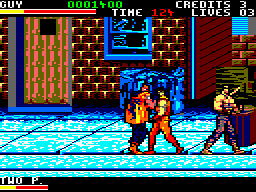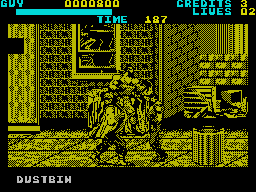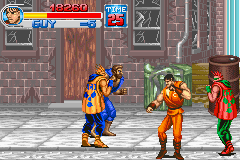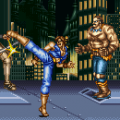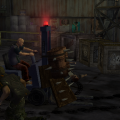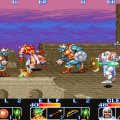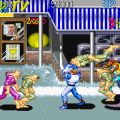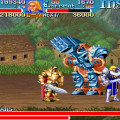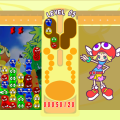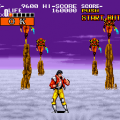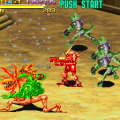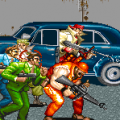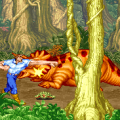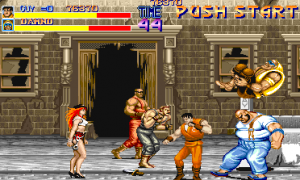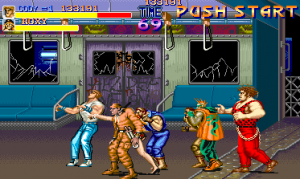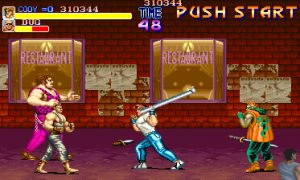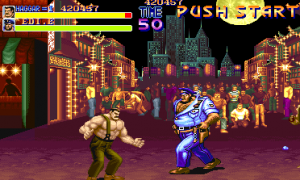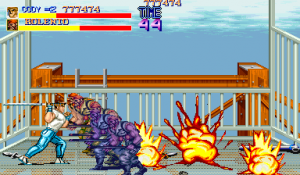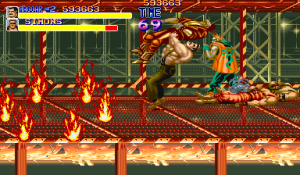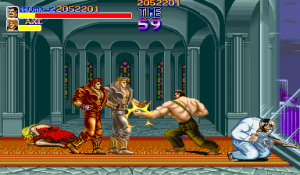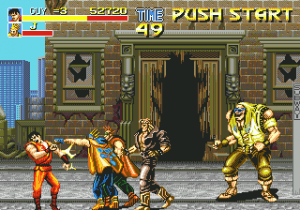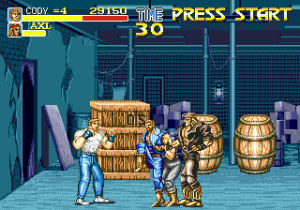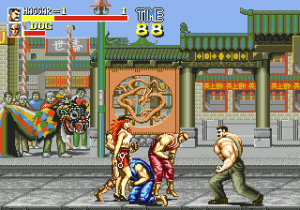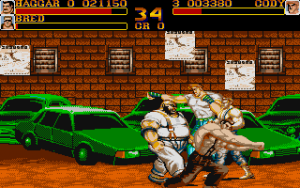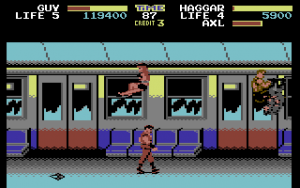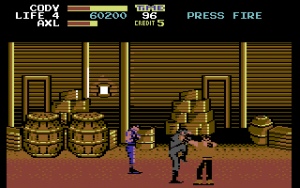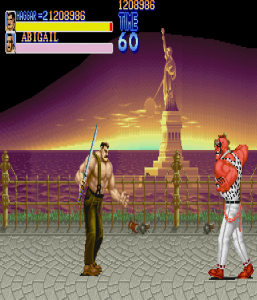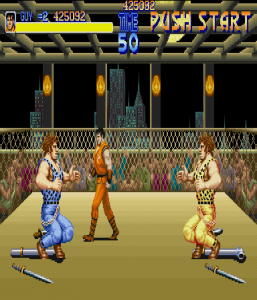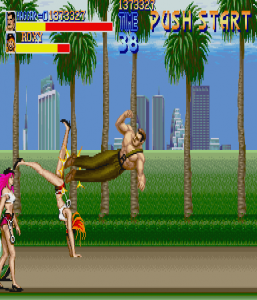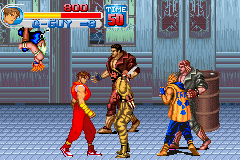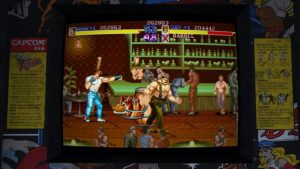Co-authored by Sam Derboo
The belt-scrolling beat-em-up genre was established by Technos’ Nekketsu Kouha Kunio-kun/Renegade, and further evolved through the same company’s Double Dragon. While there were other similar games from competitors, the most important one, the one that established so many conventions for the genre across the next decade, was Capcom’s Final Fight.
Final Fight was directed by Yoshiki Okamoto, who developed games for Capcom like Son Son and Side Arms, and had previously worked at Konami on titles like Gyruss. The visuals were designed by Akira Nishitani and Akira “Akiman” Yasuda, both of who had previously worked together on Forgotten Worlds, and later help create the world-famous Street Fighter II two years later. Indeed, Final Fight was originally titled “Street Fighter ’89”, positioned as a spin-off from their one-on-one fighting game released a few years earlier. While separate series that play quite differently, both franchises have been intrinsically linked from the beginning.
Final Fight takes place in Metro City, very obviously based on New York City. Throughout the 1980s, the metropolis had suffered from high crime rates, inspiring a large number of movies featuring drugs, gangs, and urban decay. Metro City has its gang of villains called Mad Gear, and they haven’t taken nicely to the election of former wrestler Mike Haggar. (The Mad Gear name comes from a Capcom racing game of the same name, released as LED Storm overseas.) To get the new mayor under their thumb, they kidnap his daughter Jessica and hold her ransom. But they picked the wrong dad to mess with, so Haggar stomps off to rescue her. He’s joined by average joe Cody, who is Jessica’s boyfriend, and ninja-in-training Guy, a friend of the group that just so happens to want to bust heads too. Cody is named after Tom Cody, Michael Paré’s character from the 1984 cult classic movie Streets of Fire, which had a similar story setup. Haggar is based on one of the cops from the manga/anime Mad Bull 34, while Guy is just a ninja because ninjas are cool.
The action in Final Fight is actually quite a bit simplified from Double Dragon. Rather than having three buttons devoted to “punch”, “kick” and “jump”, there’s only “attack” and “jump”. Attacking will automatically create a combo of a few weak hits then a strong attack that will knock the enemy to the ground. You can still grab enemies to either smash them a few times or through them across the screen, and there are two types of jumping attacks – a kick that will knock enemies down, and a flying knee that will just stun them. As with Double Dragon, there are plenty of weapons to pick up and use, including pipes, swords, and knives.
New to Final Fight are special moves, activated in the arcades by hitting both buttons simultaneously, which will cause your character to spin around and attack all of the enemies around them, knocking them away and giving you a breather. Known as “crowd clearing attacks” in beat-em-up lingo, these also drain a little bit of health if you hit anything, so you can’t just use them whenever you want, but using them properly will save you from being overwhelmed. Also strewn throughout the levels are trash cans, oil barrels, boxes, and other destructible objects that can drop weapons, health items like chickens and apples, or items that just grant some points. Enemy health bars appear along with their names, displayed below your own characters, giving you an idea of how many hits it’ll take before they go down. Aspects like the enemy health bars, the health-draining moves, and healing items found in literal garbage are considered standard in the beat-em-up genre, but they all started in Final Fight.
The trio of characters play similarly but there are some differences. Each character has slightly different strength and speed balance – Guy is quick but relatively weak, Haggar is strong but slow, while Cody is at the middle of the spectrum. Each has their own special ability, too – Haggar demolishes enemies with a devastating piledriver besides his standard suplex throw and favors pipes, Guy can execute a wall jump kick from vertical obstacles and is stronger with swords, and Cody is especially skilled with knives, which certain enemy types drop in rich supply.
Despite a quite limited range of actions compared to Double Dragon, Final Fight is simple only in concept. It wants you to lose, it wants to humiliate you, and it wants your money. Up to eight enemies crowd up the screen and gang up on you at once, regardless if you’re playing alone or with a friend, and once someone hits you, you’re trapped in stunlock until you’re smashed to the ground. If you get swarmed by a group of enemies, the life-depleting special attack is pretty much the only chance to get out of that mess. The later bosses get increasingly unfair; difficulty is achieved by exaggerated invulnerability times and moves that drain more than half your health in a single hit, while only perfect split-second timing can counter most of their attacks. The only way to stay alive more than a couple of seconds is to exploit every single flaw in the AI. You’ll find yourself spending minutes jumpkicking back and forth some of the strongest foes, just because that’s the safest, slow way of taking them out.
It’s also very skimpy on lives – one credit only gets you two lives with default dip switch settings, and you’ll run through them fast. Only if you’re lucky, the machine operator was kind enough to enable regular extra lives for score. At least when dying the game cuts you a little slack, as all enemies are knocked to the floor immediately. In order to suck more quarters out of the player, the continue screen has the character tied up to a piece of dynamite about to explode. To save his digital life, players had to plunk more change in the machine. It’s an interesting way to elicit pity in a gamer, though it’s not nearly as nasty as the buzzsaw from the arcade version of Ninja Gaiden. While the home ports are compromised in various ways, they also have much lower difficulty levels, so they might actually be more approachable despite their compromises.
Even though it’s brutal, there’s a reason why Final Fight became such an influential part of the genre. The characters are not only gigantic but they’re smoothly animated. The action is fast, snappy, and satisfying, the sound effects brutal and crunchy. It’s the reason why beat-em-ups are as satisfyingly as they are, because it’s immensely satisfying just to walk forward, pummel enemies until the screen indicator tells you to “Go!” to the next area, and then pummel some more.
The game takes place over the course of a single day, beginning in the slums, going down to the subway tunnels, where you’ll ride through trains covered in graffiti; a fancy bar, which nonetheless has an underground fighting ring; an industrial area, where you’ll need to dodge flames on the floor; the bay area, where you take on thugs on a long stretch on the beach as dusk breaks; and finally storm the penthouse of Mad Gear’s boss, the wealthy Belger. Part of the industrial area takes place on an elevator, as goons drop in to fight, a trope that has been mimicked in countless other beat-em-ups.
As with Double Dragon, Capcom’s artists created a memorable rogue’s gallery. There are generic goons and spiky-hair punks wearing distinctive jackets, but there are also bald, obese guys that pack quite a punch, and thugs that attack judiciously with knives and Molotov cocktails. The cackling dreadlock-wearing Damnd will temporarily escape from the brawl while whistling to call his underlings in, while a hulking wrestler named Andore (obviously based on Andre the Giant) can and will easily suplex you. A mask-wearing football player named Sodom will fight you in an underground fighting ring, while Rolento jumps around and lobs grenades from above. Poison (and her palette swap Roxy) is the game’s solely female enemy type, with bright colored hair, white tank top, and hot pants. There’s a corrupt cop named Edi E, who spits out his gum when you first hit him, which you can then pick up and consume for a high score bonus. The final boss, Belger, initially shows up riding a wheelchair, equipped with a crossbow and holding Jessica his hostage. But his disability is just for show, as he’ll easily attack on foot until it’s destroyed…at least until you hit him enough that you knock him out of his highrise window and down onto the pavement below. Many of these characters have shown up in later Street Fighter games as well, as part of a larger shared universe.
One of the most amusing parts of Final Fight is the bonus round where you smash some poor sap’s car – a nifty feature that made a return in the Street Fighter II games. Once you finish demolishing it, some random bad guy runs out and screams, in a goofily digitized voice, “Oh My God!”. The second bonus stage, a factory hall of window panes to destroy, is not quite as fun nor as iconic. There’s also a trick dubbed “alchemy” by Japanese fans, where you can get high scoring items to appear from destroyed items if you move the joystick immediately after they break.
Final Fight‘s success was not only due to its high quality but also its timing. While Double Dragon was extremely popular, particularly in North American arcades, Technos was seemingly more interested in expanding its Kunio-kun line of games on console platforms; Double Dragon II wasn’t much of an evolution over its predecessor, and they didn’t even bother to develop Double Dragon III themselves, instead outsourcing it to another company. With the former king of beat-em-ups on the ropes, Final Fight knocked them out and crowed themselves the new champion, a move which Technos never quite recovered from.
SNES Versions
Of course, Finial Fight was quickly ported to home platforms. The initial port of Final Fight – and probably the most popular – is also incredibly butchered. A quick look at the pictures and one would think that it’s a spot-on conversion of the original, and it’d almost be right. While some of the animation has been cut, it does look quite good. And it actually plays just as well, although it oddly enough adds additional stopping points in each stage, where one must clear all of the enemies to proceed.
It’s hard to say what the biggest problem is, but one that takes the cake is that only Cody and Haggar are playable, completely cutting out Guy. Capcom took this to heart and actually released a version called Final Fight Guy, which aside from minor tweaks was mostly the same – except Guy took the place of Cody. It was released in America only through Blockbuster outlets. That’s not even the beginning of the issues. Two player mode is gone entirely, eliminating one of the biggest draws of the game. The fourth stage, the factory level where you fight Rolento, is gone entirely. Little things, like the transitions between screens (like your character bashing down a door or being captured by Andore and tossed into the ring) were deleted, too. Animation frames were removed quite liberally as well, making the game feel a bit less smooth. The SNES Final Fight was one of the first games for the system and perhaps Capcom couldn’t fit all it wanted to with limited technology and time, but it’s still incredibly slipshod compared to the ports that came after it.
The number of enemies on screen is severely cut down – only three attackers have to be dealt with at a time, and as soon as barrels start rolling on top of that number, heavy flickering ensues. On one side the limitation is actually for the better, since one is now forced to take them on alone, and the result is a much more forgiving game, even though enemies aren’t knocked over anymore when the player dies (but there’s a short respawn invincibility now). The bosses are still just as unfair, though. Continuing after losing all lives also takes you back to the very beginning of the stage (which, later in the game, is a lot), and the number of total credits is limited.
Nintendo’s content control also strikes again, as usual. Some of the bosses’ names have been changed (“Damnd” became “Thrasher” and “Sodom” became “Katana”) and other little bits of censorship are noted throughout – whiskey is no longer available as a bonus item, Poison and Roxy were changed to men named Sid and Billy, and the guy screaming “Oh My God!” also has his line changed to “Oh My Car!” The design of Belger’s chair was also redesigned to look less like a wheelchair.
Final Fight CD
The Sega CD port of Final Fight – done by Sega – is actually one of the better console ports. It has all of the stuff that was deleted from the SNES version, plus an additional time attack mode that challenges you to beat up as much thugs as you can (on an all-new background) in a set amount of time. The intro has been slightly extended to show some of the enemies of the game, and both the intro and ending are fully voiced. (The actor playing Haggar in the English version sounds quite bored with his job, though.) The music has also been entirely remixed to take advantage of the CD audio. The main downside with this edition is that the graphic quality had to be sacrificed so it would work with the Sega CD’s 64 color palette, so it looks a bit grainy when compared to other games on the system. While it can display four enemies on screen compared to the SNES version’s three (though not as many as the arcade version), attack speed is also slowed down for some reason, in making the game actually harder in a way. There’s still some of the same minor name changes, but otherwise this used to be one of the best ways to go on consoles before the emulated releases showed up.
The home ports, by the way, restore one scene from the intro that was cut from the American arcade version, where you see Jessica tied up – she’s only wearing a bra on most platforms, while she’s in a dress in the SNES, Super Famicom and Sega CD versions. The SNES version also slightly changes the dialogue to make it sound less like she’ll be assaulted if Haggar doesn’t give into Mad Gear’s demands. This scene is cut entirely out of the “World” arcade version, featuring only a close-up of Damnd and loud shrieking coming from the TV.
Home Computer Versions
As with many arcade games of the ’80s, U.S. Gold licensed Final Fight to bring it to all the mainstream home computers in Europe. All of those rely on a 1-button layout (even when playing with the keyboard instead of a joystick), resulting in very awkward combinations of the fire button and directions for special and jump attacks. The normal combo thus can only be initiated while standing still. Even the most miserable of these ports manage something the SNES couldn’t do, though: They feature all three characters, and they support two player mode. The latter is pretty much required in the Amiga and Atari ST versions, as a single player has no fighting chance to get out of the constant enemy stunlock attacks. They look close enough to the arcade game, aside from a smaller color palette, a huge black bar for status information. The Amiga version has squished graphics as a result, while the Atari ST just cuts away the upper part of the screen. Both completely abolish the destructible objects from the original, and have items just lying on the street instead. Audio-wise, you got the choice between sound effects only on the Amiga and a horrible short loop of music played in the ST version.
The C64 port seems adequate enough for the platform. It uses completely redrawn graphics with much smaller sprites, and is actually the most playable of the U.S. Gold versions. It also features a great SID music track, but only on the title screen and character select menus, in game it’s just as silent as the other 8-bit versions. Unfortunately, the game is rendered pointless by the AI’s utter lack of countermeasures for the wildly overpowered forward jump kick. It also introduces a new low of two enemies on screen max. As usual the Amstrad CPC and ZX Spectrum versions are just unplayable, regardless of their somewhat competent visuals.
One computer version got damn near delivering the perfect arcade experience. Only Westerners didn’t get to see any of it, as it appeared on the Japanese X68000, famous for many of the best arcade-to-home ports of the early 1990s. There’s really not much to distinguish it from the real deal, aside from not quite being able to fit as many enemies on screen as the arcade original. It also features one outstanding MIDI arrangement of the soundtrack.
Final Fight One
In the spirit of resurrecting a bunch of its old titles for the Game Boy Advance, Capcom actually did a good service to Final Fight One. Practically all of the things that the SNES version did wrong have been fixed – all three characters are playable, there’s a two player mode (though you need two cartridges), the scene transitions are back and all of the levels are intact. There’s also a handy save feature inbetween levels, as well as several bonus features. Beat enough bad guys, and you’ll unlock several different bonuses, including different colors, the ability to play as Cody and Guy using their Street Fighter Alpha versions, and a rapid punch ability that makes your character hammer bad guys at an insane rate. There are still some weird issues – there are now awkwardly translated dialogue scenes, but they all use terrible looking character portraits, compared to Shinkiro’s SNK-style artwork featured on the cover. The music has been significantly cut back, and the American version still has the female enemies cut out.
Emulated Versions
The original Arcade version of Final Fight has been featured on the Capcom Classics Collections for the PS2, Xbox, and PSP. There is also a version featured in Final Fight Streetwise, but it is poorly emulated with an extremely choppy framerate and not worth bothering with. The Xbox Live Arcade and PSN releases have oddly been bundled with the fantasy brawler Magic Sword as Final Fight Double Impact. These allow to chose from various resizing options and filters, and also feature a cool recreation of the arcade cabinet around a fake angled CRT look. They also add a lot of additional score and time challenges during play. With support for online multiplayer, these are now the definitive versions for home use. The Wii Virtual Console had the SNES version, alongside its two sequels. The Capcom Beat-em-up Bundle has the arcade Final Fight, with both regional variations, as well as several other arcade Capcom beat-em-ups, and it appears on the Capcom Arcade Stadium as well.
Comparison Screenshots
